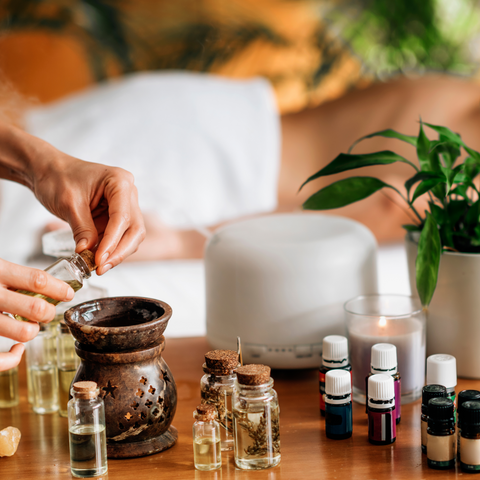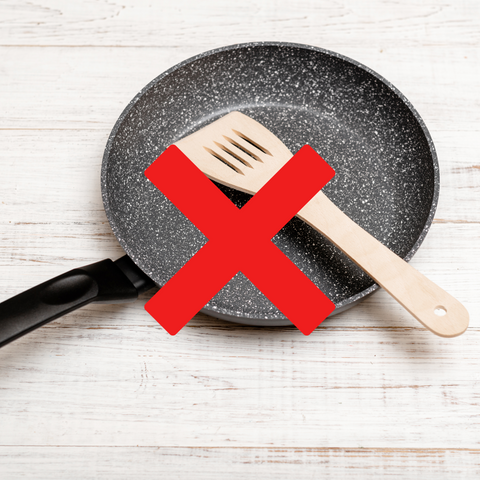
5 Steps to Eliminate Toxins From Your Home
Share

First off, we should address toxins: what are they anyway and why should we worry about them?
A toxin can be described as a substance made by a plant, animal, or microorganisms, that is harmful to another organism.
In this instance, humans are the “other organism” and toxins can pose serious risks like respiratory issues, reproductive issues, allergic reactions, cancer, asthma, poisoning, diarrhea, headaches, blindness, endocrine disruption, skin burns, and liver and kidney problems.

Sometimes it’s hard to believe that we live in a world surrounded by toxins - our home, our work, your child's school or daycare, the busy road you drive on, the grocery store, your favorite coffee shop… you get the picture. Although we can mitigate our exposure to toxins in our daily lives through making changes to our activities, it is extremely difficult and downright near impossible to eliminate them completely. However, if we start by eliminating toxins in the place you spend most of your time (at home), then we can essentially eliminate up to 90% of the toxins you are exposed to on a daily basis.
Since it’s impractical for someone to immediately eliminate all toxins from your home, here we are going to focus on the things that contribute most to your home's toxic pollution and talk through how you can mitigate them in a practical sense at a pace that works best for you and your family.
Step 1 - Safeguard your Skin

As I’m sure you’ve heard, your skin is your biggest organ and constantly absorbs what you put on it! When you think about it, we are CONSTANTLY exposing our skin to external things nearly every second of every day with our clothes, our showering products, our skin care products, makeup, bed sheets, furniture, and so on. In fact, a peer-reviewed study showed your underarms and genital region have a 100% absorption rate and that your entire body has a 100% absorption for fragrance ingredients.
The majority of common body care products and products we use on our skin contain a cocktail of carcinogenic chemicals, allergens, and irritants and will likely make their way into your body, blood and lymphatic system.
To eliminate most of the exposure your skin has to toxic chemicals, preservatives, and fragrances that are harmful to our bodies, make the switch to certified organic and non-toxic skin care, shower, and laundry products.
Step 2 - Address Your Air Fresheners

Most store bought candles are made of paraffin wax, a wax that when melted emits highly toxic chemicals like benzene and toluene - the same chemicals found in diesel fuel fumes. Other chemicals commonly found in air fresheners like aerosols and plug-ins include ethyl/isopropyl alcohol, which can be extremely dangerous if absorbed through the skin, inhaled, or ingested; and formaldehyde, a common preservative, which, if inhaled, can cause difficulty breathing, trigger an asthma attack, cause throat irritation, induce headache, and is also an irritant to your mucous membranes.
Contradictory to what the mainstream air freshener brands may advertise, these products are not cleansing the air in your home, but in fact poisoning it and filling it with toxic chemicals. In fact, a recent study done by the EPA on human exposure to air pollutants indicated that indoor levels of pollutants may be two to five times (and occasionally more than 100 times) higher than outdoor levels.

Luckily, there are many incredible options to deodorize your home and to fill it with safe and cleansing scents. In addition to keeping your house well ventilated, some common non-toxic alternatives to deodorizing and making your home smell fresh include: non-toxic candles made with all non-toxic and natural ingredients, non-toxic carpet cleaners of baking soda and essential oils, diffusing essential oils, and non-toxic room spritzers made with essential oils.
Step 3 - Ditch the Toxic Cleaning Supplies

The most common toxic products found in our homes include cleaning products like laundry detergent, toilet cleaners, bleach, dishwasher detergents, and surface cleaners. Many of these products can not only cause harm with direct exposure like through ingestion or direct application to the body, but also through indirect contact such as inhalation of fumes or by touching surfaces that have been exposed to the product.

Common household cleaning products can be replaced with equally as powerful non-toxic options that are safe and protect you and your family from dangerous germs. Powerful ingredients such as essential oils, distilled white vinegar and baking soda have been used for hundreds of years (or longer) and have had infinite amounts of successful usage.
Some studies have found that distilled white vinegar was found to be strongly antimicrobial and decreased the presence of Staph, E. coli, M. tuberculosis, and flu viruses. Other studies have found that essential oils like eucalyptus, tea tree, lemon, rosemary, lavender, citrus, lemongrass and peppermint are powerful disinfectants, are anti-bacterial, anti-microbial, deodorizers, anti-inflammatory, anti-viral, and antifungal. A recent study at the Florida SW State College found that “tea tree oil and lemon oil are effective in killing the E. coli bacteria”.
Step 4 - Swap Cookware and Food Storage Containers

With the kitchen being the heart of the home, it is no wonder that a recent survey reported that we spend over 400 hours on average in the kitchen each year and spend an average of 67 minutes per day in their kitchens. With that being said, you can imagine how important it is to eliminate toxins from your kitchen and the most toxic items in your kitchen are likely your Tupperware and cookware.
Most food storage containers are made of plastic materials like PVC, polystyrene, and BPA and have been found to leach carcinogenic, hormone-disrupting phthalates, and cancer-causing dioxins when used over and over again. In fact, containers made of polystyrene (PS, or plastic #6, also known as Styrofoam) has been associated with skin, eye and respiratory irritation, depression, fatigue, compromised kidney function, and central nervous system damage. Although it is more eco-friendly to reuse food storage containers, it is advised to swap foods out of the plastic wraps and containers once the groceries are at home to reduce the amount of chemicals that may leach from the container into your food.
Fortunately, there are many alternatives to toxic food storage containers and simple habits you can do to avoid these containers at the store. Some food storage alternatives include reusable glass or stainless steel Tupperware with a silicone sealing ring to prevent spills, beeswax wrap to replace cling wrap, cotton food saver bags for produce, and reusable silicone snack bags. A few ways you can avoid purchasing toxic food storage containers from the grocery store would be to buy in bulk and bring your own containers and buy only items packaged in glass or paper.

The FDA conducted a recent study on PFAS, a group of about 5,000 synthetic compounds often found in nonstick cookware, and found them lurking in our food supply and present in the blood of 98%of the U.S. population. Other chemicals like PTFE, a fluoropolymer made from PFAS, and PFOA (perfluorooctanoic acid), have been linked to liver damage, multiple types of cancers, thyroid disease, infertility issues, high cholesterol, and several other health conditions. Teflon is the most commonly used brand of nonstick cookware on the market and also the most dangerous, but many people choose this non-stick material because it’s convenient and ubiquitous. Some cookware may even advertise themselves as PTFE or PFOA-free, however, once the nonstick coating is chipped, the cookware immediately becomes toxic and hazardous to your health.

Alternatives to toxic cookware include real cast iron and stainless steel cookware. Cast iron is a safe cooking option that heats well and evenly, and can even be seasoned to make it nonstick. It is non-toxic and can actually increase your iron levels by adding safe levels of iron into your food while it cooks. Another alternative is stainless steel cookware. This is also a great non-toxic option and is best known for its light weight and resistance to scratches. Like cast iron, it can also be seasoned to be nonstick!
Step 5 - Buy Organic Produce

With the growing demand of mass produced produce also comes the increased use of pesticides and herbicides on produce so farmers can increase their production output. Consequently, there is a growing concern for the increased amounts of pesticide residues that remain on our produce even after processing. In fact, according to a health advocacy group, about 70% of produce sold in the US has pesticide residues on it even after it is washed. While the EPA tests each individual pesticides and determines “safe levels” of use for each,
the safety of consuming combinations of pesticides on produce has NOT tested for,
and almost a third of the produce the USDA tested had residues from two or more pesticides.
Studies have shown farmers with long-term exposure to pesticides have increased risk of Alzheimer's and Parkinson's disease, cancers, depression, respiratory issues, and other chronic health problems.

One way to avoid consuming harmful pesticides is by buying organic and even better, buying locally organic produce. In general, organic produce suggests that the produce was grown without the use of pesticides.
However, as a warning, I will note that many mass produced organic farms use pesticides, but they are not toxic pesticides. If a farm has inadequate outputs after trying natural pest deterrents, then they are permitted to use naturally-derived and non-synthetic pesticides. These approved pesticides for organic farms are derived from a natural origin and are produced from naturally-occurring processes such as composting, fermentation, heating, or enzymatic digestion.
In conclusion, organic produce is significantly safer than non-organic produce with small, local, organic farms the safest because they are more likely to use less pesticides.

Another alternative to buying organic produce to lessen pesticide ingestion is by growing your own organic produce. That way you know exactly what goes into growing it!
To conclude, although you can majorly reduce your exposure to harmful toxins to you and your family at your home, it is not possible to fully emit all toxins from your life without making MAJOR changes (which are generally unachievable for your average family without completely living off the grid in your EarthHome growing and producing everything you use). However, these five steps can help improve the health of your home and your family and start you on a journey to cleaner and healthier living.
